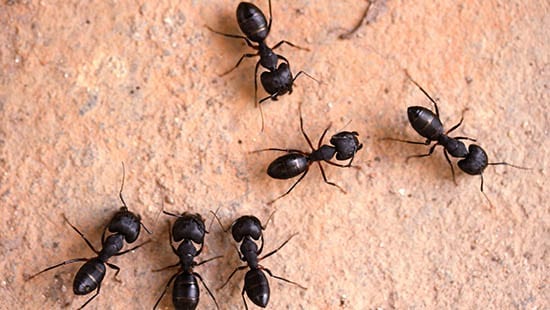Les fourmis : des nuisibles complexes mais contrôlables

La lutte contre les fourmis est complexe en raison du grand nombre de types de fourmis et des différences biologiques, comportementales et alimentaires entre chaque type. Il existe plus de 12 400 espèces de fourmis dans le monde et environ 1 000 espèces connues aux États-Unis. Bien que seulement 25 d’entre elles environ soient considérées comme des nuisibles et moins encore tendent à vivre dans une zone géographique donnée, la présence d’une seule fourmi dans une usine de transformation des produits alimentaires peut indiquer un problème plus important et nuire à la sécurité alimentaire. Dès lors, il est capital d'identifier le type de fourmis pour les contrôler et les éliminer.
Comprendre le comportement des fourmis
L'élimination efficace repose sur la bonne compréhension du comportement alimentaire et social des fourmis envahissantes. Par exemple, si l’appât est placé dans un endroit où elles ne passent pas, ou s’il s’agit d’un aliment qui ne les attire pas, l’appât ne fera pas grand-chose d’autre qu'amasser de la poussière. Si vous cherchez un nid de fourmis à l’extérieur alors qu'il s'agit d'une colonie de fourmis nichant à l’intérieur, vous perdrez beaucoup de temps. Si vous ne traitez qu'une colonie de fourmis parmi plusieurs nids, l'infestation ne sera certainement pas résolue.
Même au sein d’une même espèce de fourmis, il peut y avoir des complexités. Par exemple, la fourmi de trottoir niche souvent sous les trottoirs et les allées par temps tempéré - puis se déplace à l'intérieur pendant l'hiver, nichant sous les fondatoins ou près d'une source de chaleur. On peut également noter des variations saisonnières dans leurs préférences alimentaires, beaucoup d'entre elles recherchant des protéines au printemps alors qu'elles travaillent à l'établissement de la colonie, puis préférant plus de sucre et de glucides en été et à l'automne.
Lutter efficacement contre les fourmis en milieu commercial
Les appâts constituent la forme de traitement la plus efficace pour la majorité des fourmis, en particulier celles qui envahissent les structures*, car les ouvrières se nourrissent de l’appât, qui contient une substance qui les attire et un insecticide, et elles le ramènent au nid pour le partager avec les autres membres de la colonie, y compris la reine qui assure la reproduction. Une fois la reine éliminée, la colonie cesse de produire de nouvelles fourmis et finit par périr. Si les tactiques de lutte ne ciblent que les fourmis ouvrières et n’atteignent jamais la reine, la colonie continuera à produire de nouvelles fourmis et les problèmes persisteront.
Pour les espèces de fourmis ou les situations où l’appât n’est pas efficace ou ne convient pas, d’autres méthodes peuvent être nécessaires, comme l’élimination physique du nid (si possible), ou un traitement ciblé à l'aide d'un insecticide résiduel soigneusement sélectionné par un professionnel qualifié.
Au-delà des appâts : ce que vous pouvez faire pour maintenir les fourmis à l'intérieur
Pour qu'un appât soit le plus efficace possible, l'accès à d'autres sources de nourriture et d'eau doit être réduit autant que possible. Cela signifie qu'il est nécessaire de maintenir un environnement propre, de nettoyer les liquides renversés et les miettes, de vider les ordures, de réparer les fuites et d'éliminer les zones d’entreposage de matériel. Il est également important de savoir que l’appât n’est pas immédiatement efficace, mais qu’il s’agit d’une solution à long terme. Bien qu’il faille parfois patienter une à deux semaines avant de ne plus voir de fourmis, nourrir la colonie et la reine avec des appâts permet d’éliminer complètement les fourmis que l’on ne voit pas, et pas seulement les quelques ouvrières que l’on aperçoit.
*Bien que l'appât soit généralement le meilleur choix pour lutter contre les fourmis, les préposés à l'application doivent toujours s'assurer que l'application spécifique est répertoriée sur l'étiquette et autorisée par les normes d'audit tierces de l'usine, et que l'appât figure bien sur la liste des produits approuvés avant toute application.
Autres ressources de lutte contre les nuisibles
Les fourmis peuvent causer de sérieux problèmes pour votre entreprise. Utilisez ce guide pour identifier les types courants de fourmis afin que vous puissiez maintenir en toute confiance un site exempt d'organismes nuisibles.
Pour lutter contre les fourmis dans votre établissement, il est capital de savoir comment localiser un nid de fourmis et de comprendre ce qui les a attirées en premier lieu.
Pouvant mordre, piquer et contaminer les aliments, les fourmis sont plus qu'un simple désagrément. Les services d’élimination des fourmis permettent de contrôler une variété de fourmis.
Les mouches peuvent transmettre au moins 65 maladies à l'homme, ce qui rend la lutte contre cet insecte particulièrement importante pour les restaurants et la grande distribution alimentaire.




